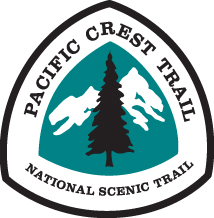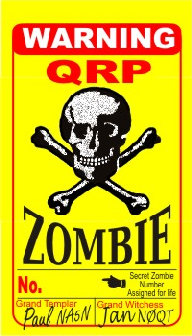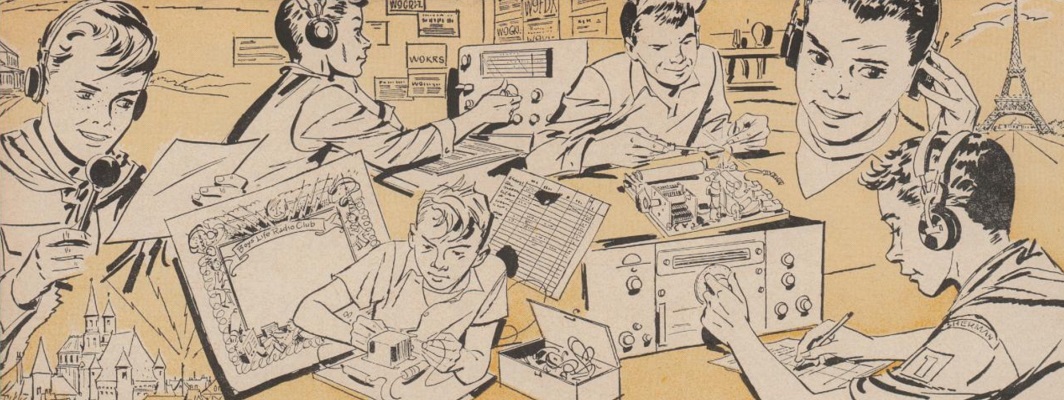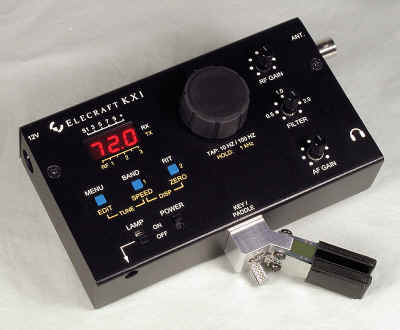Ham radio and trail hiking have been a natural pair. There are a few hams (that I know of) who have stood out over the last few years in hitting the trails with their amateur radio gear.
 The first is Ed, WA3WSJ. He has been out on the Appalachian Trail (or AT) numerous times and has brought along a minimalist setup to get on HF and make some contacts. Chances are that you have heard of the Appalachian Trail – it streches from Georgia to Maine and allows an individual to hike from start to finish.
The first is Ed, WA3WSJ. He has been out on the Appalachian Trail (or AT) numerous times and has brought along a minimalist setup to get on HF and make some contacts. Chances are that you have heard of the Appalachian Trail – it streches from Georgia to Maine and allows an individual to hike from start to finish.
 Ed’s an advocate of pedestrian mobile (WA3WSJ/pm) and has published a few books that tells of his experiences and offers advice for those interested in following his footsteps. He also has established the Great Outdoor Radio Club, which offers resources to avid and aspiring radio trail men.
Ed’s an advocate of pedestrian mobile (WA3WSJ/pm) and has published a few books that tells of his experiences and offers advice for those interested in following his footsteps. He also has established the Great Outdoor Radio Club, which offers resources to avid and aspiring radio trail men.
Another amateur radio hiker is Dennis, K1YPP. He actually completed the Apalachain Trail and also wrote a book on his expierences. Hiking from one end to the other involves reducing the backpack weight as much as possible. Dennis successfully used QRP rigs during his time on the trail.
Here is a podcast of two hams who discuss hiking the Appalacian Trail, including the use of amateur radio (ham radio) and QRP (low power, less than 5 watts) along the way. From the series at Atlanticon 2006 in Timonium, MD.
The APRS folks also are involved in activities on the Appalachian Trail (check out here and here).
 Heading west, the next major trail is the Continential Divide Trail. The trail goes from Mexico to Canada and spends a good portion of its time following the Rocky Mountains. Although not a dedicated Continential Divide Trail hiker – Steve, WG0AT, has spent plenty of time in the Rocky Mountains making amateur radio contacts. Steve’s take on hiking is a bit different as he brings two goats with him that help carry the equipment. If you have not seen his Youtube videos, then you are missing out.
Heading west, the next major trail is the Continential Divide Trail. The trail goes from Mexico to Canada and spends a good portion of its time following the Rocky Mountains. Although not a dedicated Continential Divide Trail hiker – Steve, WG0AT, has spent plenty of time in the Rocky Mountains making amateur radio contacts. Steve’s take on hiking is a bit different as he brings two goats with him that help carry the equipment. If you have not seen his Youtube videos, then you are missing out.
Bob, K0NR, is also active in the Rockies… having most recently participated in a unique ham radio event – The 14er. Paul, W0RW, is an pedestrian mobile ham who has taken to the mountains to log contacts. However, I do not think either Steve, Bob, or Paul have actively hiked the Continental Divide Trail along with their rigs.
 Further west is the Pacific Crest Trail. I was curious to find that not many hams head to the Pacific Crest Trail for hiking and QRP work either. There is a repeater guide by Bill, AA6J – but I am not sure how much of the trail he has hiked or if he brought any HF gear. The only ham I can find that has attempted the hike was Bruce, N7RR. It also looks like he did not make it all the way. Being a Californian, I am surprised that more west coast hams have not hit the trail along with their HF radio gear.
Further west is the Pacific Crest Trail. I was curious to find that not many hams head to the Pacific Crest Trail for hiking and QRP work either. There is a repeater guide by Bill, AA6J – but I am not sure how much of the trail he has hiked or if he brought any HF gear. The only ham I can find that has attempted the hike was Bruce, N7RR. It also looks like he did not make it all the way. Being a Californian, I am surprised that more west coast hams have not hit the trail along with their HF radio gear.
Have you had a QSO with a ham on the Appalachian Trail, Continental Divide Trail, or Pacific Crest Trail?

How do you feel about the idea of packing up a rig and heading for the mountains?
 I participated in a CW QRP event! Why not? It was actually a pretty good time.
I participated in a CW QRP event! Why not? It was actually a pretty good time.

 The first is Ed,
The first is Ed,  Ed’s an advocate of pedestrian mobile (WA3WSJ/pm) and has
Ed’s an advocate of pedestrian mobile (WA3WSJ/pm) and has  Heading west, the next major trail is the
Heading west, the next major trail is the  Further west is the
Further west is the 


 My intent this morning was to shake-out my portable operations gear. I am travelling out to California next week, enroute to Seattle and then Korea. For the flight to Korea I am allowed to take two duffel bags (<70 lbs each) and a carry-on. I get to ship a small amount of gear (aka "household goods") from here in Kansas to Korea, but I likely will not see that stuff again for a few weeks. So along with all the stuff I will need to function for a few weeks, I also want to bring some radio gear.
The current plan is to use the Elecraft KX1. The rig has a tiny footprint and includes its own tuner and tiny set of paddles. For an antenna, I'm going to use my Buddistick. All the components fit into a small case. I decided to take the KX1 and Buddistick out for a test drive and see how everything worked together.
I set up in a small park in Leavenworth on a bluff overlooking the the Missouri River. My dad had given me a heavy duty tripod from High Sierra that served as a great base for the Buddistick. The tripod is too big pack with my luggage, but I am definitely going to ship it with the rest of my household goods. I also brought along MFJ-259B to help tune the Buddistick. The Buddistick comes with a 31' radial. I found the challenge with the Buddistick is keeping the radial off the ground (as recommended). Instead of the 5.5' whip that comes with the Buddistick, I have the MFJ-1956, a 12' telescoping whip.
40M tuned up quick. I had the radial extended out all the way to 31'. Due to where I was at, there was no nearby tree that allowed me to get the radial up off the ground. The tripod let me raise up the Buddistick about 6'. It was interesting to see the SWR change as I adjusted the height. After connecting up the KX1, I found W5VYH, Bru, calling CQ around the old 40M Novice band. Bru was down in Arkansas and gave me a 559. Next up was 30M. After playing with the coil clip, I got the SWR down. Not much heard there. 20M was a bit harder to tune up. After playing with the coil clip and rolling in the radial, I was able to get the SWR down to 1:1.7. 20M was very busy with a bunch of station around 14.150 MHz. I responded to one or two stations calling CQ, but I imagine my small sized signal was hard to pull out of the mix.
I'm going to try a few more trial runs. Also need to try out the adjustable clamp that comes with the Buddistick as a mount.
My intent this morning was to shake-out my portable operations gear. I am travelling out to California next week, enroute to Seattle and then Korea. For the flight to Korea I am allowed to take two duffel bags (<70 lbs each) and a carry-on. I get to ship a small amount of gear (aka "household goods") from here in Kansas to Korea, but I likely will not see that stuff again for a few weeks. So along with all the stuff I will need to function for a few weeks, I also want to bring some radio gear.
The current plan is to use the Elecraft KX1. The rig has a tiny footprint and includes its own tuner and tiny set of paddles. For an antenna, I'm going to use my Buddistick. All the components fit into a small case. I decided to take the KX1 and Buddistick out for a test drive and see how everything worked together.
I set up in a small park in Leavenworth on a bluff overlooking the the Missouri River. My dad had given me a heavy duty tripod from High Sierra that served as a great base for the Buddistick. The tripod is too big pack with my luggage, but I am definitely going to ship it with the rest of my household goods. I also brought along MFJ-259B to help tune the Buddistick. The Buddistick comes with a 31' radial. I found the challenge with the Buddistick is keeping the radial off the ground (as recommended). Instead of the 5.5' whip that comes with the Buddistick, I have the MFJ-1956, a 12' telescoping whip.
40M tuned up quick. I had the radial extended out all the way to 31'. Due to where I was at, there was no nearby tree that allowed me to get the radial up off the ground. The tripod let me raise up the Buddistick about 6'. It was interesting to see the SWR change as I adjusted the height. After connecting up the KX1, I found W5VYH, Bru, calling CQ around the old 40M Novice band. Bru was down in Arkansas and gave me a 559. Next up was 30M. After playing with the coil clip, I got the SWR down. Not much heard there. 20M was a bit harder to tune up. After playing with the coil clip and rolling in the radial, I was able to get the SWR down to 1:1.7. 20M was very busy with a bunch of station around 14.150 MHz. I responded to one or two stations calling CQ, but I imagine my small sized signal was hard to pull out of the mix.
I'm going to try a few more trial runs. Also need to try out the adjustable clamp that comes with the Buddistick as a mount.


 It has been a long time goal to be able to sit in a comfy deck chair out in the backyard and have CW QSOs using my
It has been a long time goal to be able to sit in a comfy deck chair out in the backyard and have CW QSOs using my  Feb 14, 1400Z-2200Z, Leavenworth, KS. Kickapoo QRP Amateur Radio Club, W0EBB. 5th Annual ‘Freeze Your Keys’ Winter Operating Event. 14.280 14.060 7.280 7.030. QSL. Gary Auchard, 34058 167th St, Leavenworth, KS 66048. w0ebb@juno.com
Feb 14, 1400Z-2200Z, Leavenworth, KS. Kickapoo QRP Amateur Radio Club, W0EBB. 5th Annual ‘Freeze Your Keys’ Winter Operating Event. 14.280 14.060 7.280 7.030. QSL. Gary Auchard, 34058 167th St, Leavenworth, KS 66048. w0ebb@juno.com
 After being away from my CW paddle for quite some time, I’ve been trying to get back into CW. Over the past few days I’ve been having success with a few QSOs. Tonight I went down to 80M and had a QSO with Ed,
After being away from my CW paddle for quite some time, I’ve been trying to get back into CW. Over the past few days I’ve been having success with a few QSOs. Tonight I went down to 80M and had a QSO with Ed,